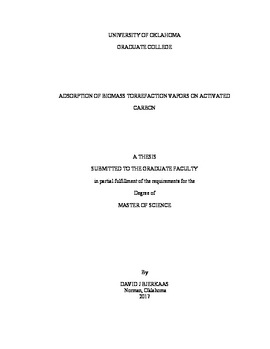| dc.description.abstract | Energy is a growing need for the modern economy; however, global reliance on nonrenewable resources is problematic. The United States transportation infrastructure in particular was built around the combustion of petroleum based liquid fuels providing the needed energy. Biofuels could be a potential replacement.
A promising method of producing biofuels is a staged thermal fractionation of solid biomass, also known as the torrefaction process. Three biopolymers make up lignocellulosic biomass: cellulose, hemicellulose, and lignin. Each of these biopolymers decompose within different temperature ranges to give different product distributions. Given that these temperature ranges only partially overlap, choosing reaction conditions going from a less severe stage 1 to a most severe stage 3 can allow for more homogenous product streams with respect to functionality. This eases the subsequent upgrading process.
The torrefaction product from stage 1 is not entirely composed of hemicellulose products; phenolic compounds are present which deactivate catalysts used to upgrade the majority of the stage 1 product streams. In order to ensure acceptable catalyst life, these compounds must be removed. Given the difficulties of distilling an oxygenated mixture, a packed bed adsorber is a promising approach to achieve this separation.
When trying to understand the behavior of a complex mixture, it is useful to select model compounds that behave similarly to their compound groups and run experiments on them alone. Two main model compounds were selected: Acetic acid to model acetic acid and light oxygenate behavior, and m-cresol to model phenolic behavior. Experiments were conducted to study the separation of m-cresol from acetic acid in a mixture. Activated carbon separates m-cresol from acetic acid quite effectively. When a stage 1 sample was analyzed, the bed separated the phenolics as well, but did not exhibit the same degree of separation as the model compound mixture. | en_US |
